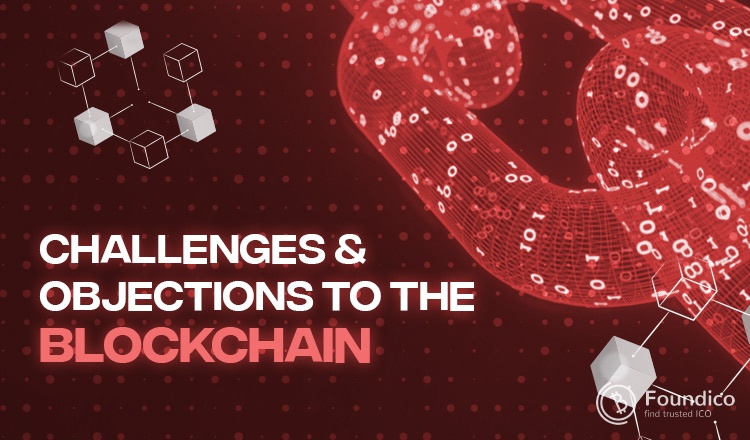Challenges & Objections to the Blockchain

Objections to the blockchain and explanations
General awareness of blockchain is still low. Most people have heard something about cryptocurrencies, however their overall knowledge about blockchain is limited. The information in the media is often negative and misleading. This implies a certain aversion to blockchain technology. Below we have collected the most common sounds objections / allegations and tried to explain the actual situation or to indicate possible solutions.
Cryptocurrency extraction is inefficient, unecological, energy-intensive and pointless
This objection mainly applies to blockchain networks based on the consensus PoW algorithm. For example, Bitcoin production consumes about 73 TWh of energy per year, which is about 0.33% of world energy consumption and also approximately consumption Austria[1]. However, newer blockchain networks use more modern consensual algorithms such as PoS (Proof of Stake), which are many times lower energy intensive. For wider deployment in an e-Government environment, we recommend avoiding PoW blockchain.
Blockchain always gradually moves towards centralization and thus loses its meaning
Especially for blockchains using PoW, we monitor grouping into so-called mining pools. For example, the largest mining association in the Bitcoin network achieves up to 30% success. For more modern blockchains using other consensual algorithms (e.g. PoS) is this risk lower and the motivation to associate in mining associations is lower. In general, the greatest possible diversity of nodes must be sought, various platforms, operating systems, geographical locations, ownership, etc.
Blockchain is used for money laundering and for payments in the grey or black economy, most ICOs are scams.
Indeed, the anonymity of payments in cryptocurrencies and the lack of regulation can lead to the use of payments in the grey and black economy. However, the proposed projects avoid cryptocurrencies as currency and use the blockchain as a database or use it in terms of asset tokenization. In the proposed projects, blockchain on the contrary, brings trust and greater transparency.
Blockchain is a disruptive technology that will cause job losses, the collapse of companies, office closures
Blockchain is a revolutionary technology and tends to disrupt existing business models and streamline processes. The result can be a local loss of jobs, but blockchain brings also many new opportunities and new business models.
Blockchain is slow (Bitcoin)
Bitcoin blockchain is much slower and has less time capacity (maximum number of transactions per minute) as contemporary, more modern blockchains. Bitcoin creates a new block approximately every 10 minutes, modern blockchains create new blocks in seconds. Bitcoin capacity is only up to 7 transactions per second (depending on the content), Ethereum up to 15 tx / sec, some more modern reach up to more than 1,000 transactions per second.
Current challenges and trends
Deviation from PoW towards other algorithms
Due to the high and ever-increasing energy intensity of consensus-based algorithms on computational power (PoW), we can notice a deviation from PoW when it comes to new blockchain projects to more energy efficient algorithms such as PoS, DPoS, etc. Overview comparing different consensus algorithms is given above in this chapter.
Efforts to reduce the amount of data stored in the blockchain and storage of larger data off-chain
Due to the requirement of fast response, smaller demands on the transmission capacity of the network or smaller blockchain node storage requirements we see an effort to minimize the amount of data stored to blockchain and transfer of larger data off-chain, meaning to other repositories outside the blockchain. Only their hashes are then stored in the blockchain to verify the authenticity of the document. Examples of off- chain storage are e.g. IPFS (InterPlanetary File system), StorJ, etc.
Asset tokenization
Asset tokenization is a strong trend in the use of blockchain. Real world assets are represented in the virtual world in the form of tokens. A token is something like a cryptocurrency, just with that difference that it represents an asset (or part of it) from the real world. It can be a means of transport (e.g. car, bicycle, yacht), real estate (e.g. cottage, holiday apartment), computing power, cloud storage capacity, emission allowances and much more. Tokens are then, with the use of blockchain, easily transferred, traded, monitored for use and, most importantly, secured against misuse by multiple uses (e.g. that an auto asset will only be assigned to one user at a time).
Smart contracts
One of the frequently mentioned trends is also the use of smart contracts in blockchain. Attractive are low costs, security, clarity, non-need of a third party and enforceability of the contract. Blockchain however, supporting smart contracts is more complex and potentially more expensive or slower. After the DAO incident in 2016, during which 50 mil. USD was stolen (returned later), it is appropriate to ask questions regarding the security of smart contracts. Due to the lack of regulation, the question of binding and law applicability is uncertain, and litigation might be problematic.
The following table summarizes some of the challenges and risks of blockchain technology:
|
Area |
Challenges and risks |
|
Adoption challenges |
User experience |
|
Applicability of the technology |
|
|
System speed |
|
|
General public trust |
|
|
Lack of awareness of the technology |
|
|
Technology barriers |
Low transaction capacity |
|
Scalability |
|
|
Security risks |
Cyber security risks |
|
Data leaks |
|
|
Limited protection of cryptographic keys |
|
|
Legal and regulatory challenges |
Unclear jurisdiction |
|
Identification of those responsible |
|
|
Legislative framework of contracts |
|
|
Personal data protection regulation |
|
|
Interoperability risks |
Lack of blockchain standards |
|
Development of suitable data models |
|
|
Suitable protocols for authentication and communication |
|
|
Energy consumption challenges |
Proof-of-work consensus algorithm |
|
Proof-of-stake and proof-of-authority scalability |
|
|
Reducing energy intensity |
Blockchain challenges and risks
